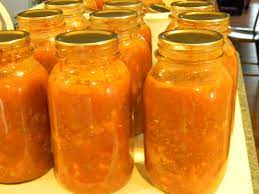Canning hamburger soup can be a convenient way to preserve a hearty and nutritious meal for later use. However, it’s important to follow safe canning practices to ensure the food remains safe to eat. Here’s a general guide on how to can hamburger soup:
Ingredients:
- Ground beef
- Vegetables (carrots, celery, onions, potatoes, etc.)
- Tomatoes (diced or crushed)
- Broth or stock
- Seasonings (salt, pepper, herbs, etc.)
Equipment:
- Pressure canner
- Canning jars with lids and bands
- Canning funnel
- Jar lifter
- Ladle
- Bubble remover tool or non-metallic spatula
- Clean towels
Instructions:
- Prepare Your Ingredients:
- Brown the ground beef in a large pot.
- Chop all the vegetables and prepare the broth.
- Season the soup according to your taste.
- Cook the Soup:
- Cook the soup until all the ingredients are tender and flavors meld.
- Ensure the soup is hot throughout.
- Fill the Jars:
- Using a canning funnel, ladle the hot soup into clean, hot canning jars, leaving about 1 inch of headspace at the top.
- Remove air bubbles using a bubble remover tool or non-metallic spatula.
- Wipe Jar Rims:
- Wipe the rims of the jars with a clean, damp cloth to remove any residue that might interfere with sealing.
- Apply Lids and Bands:
- Place sterilized lids on the jars and screw on the bands until they are fingertip-tight.
- Process in a Pressure Canner:
- Follow the manufacturer’s instructions for your pressure canner.
- Process the jars according to the recommended pressure and time for your altitude and the type of ingredients in the soup.
- Cool and Check Seals:
- Allow the jars to cool naturally on a clean towel or cooling rack.
- Once cool, check the seals by pressing down on the center of each lid. If it doesn’t pop back, the jar is sealed.
- Label and Store:
- Label the jars with the date and contents.
- Store the sealed jars in a cool, dark, and dry place.
Important Tips:
- Use a Pressure Canner: Since this is a low-acid food, it’s crucial to use a pressure canner to prevent the risk of botulism.
- Follow Canning Guidelines: Always follow safe canning guidelines and recommendations from reputable sources, such as the USDA or your local extension service.
- Adjust for Altitude: Processing times and pressures may vary based on your altitude, so be sure to adjust accordingly.
- Check Seals: After cooling, check that each jar has sealed properly. If a jar hasn’t sealed, refrigerate and consume its contents promptly.
Remember, safety is paramount when it comes to home canning. Always refer to reliable sources for up-to-date and detailed canning instructions.
